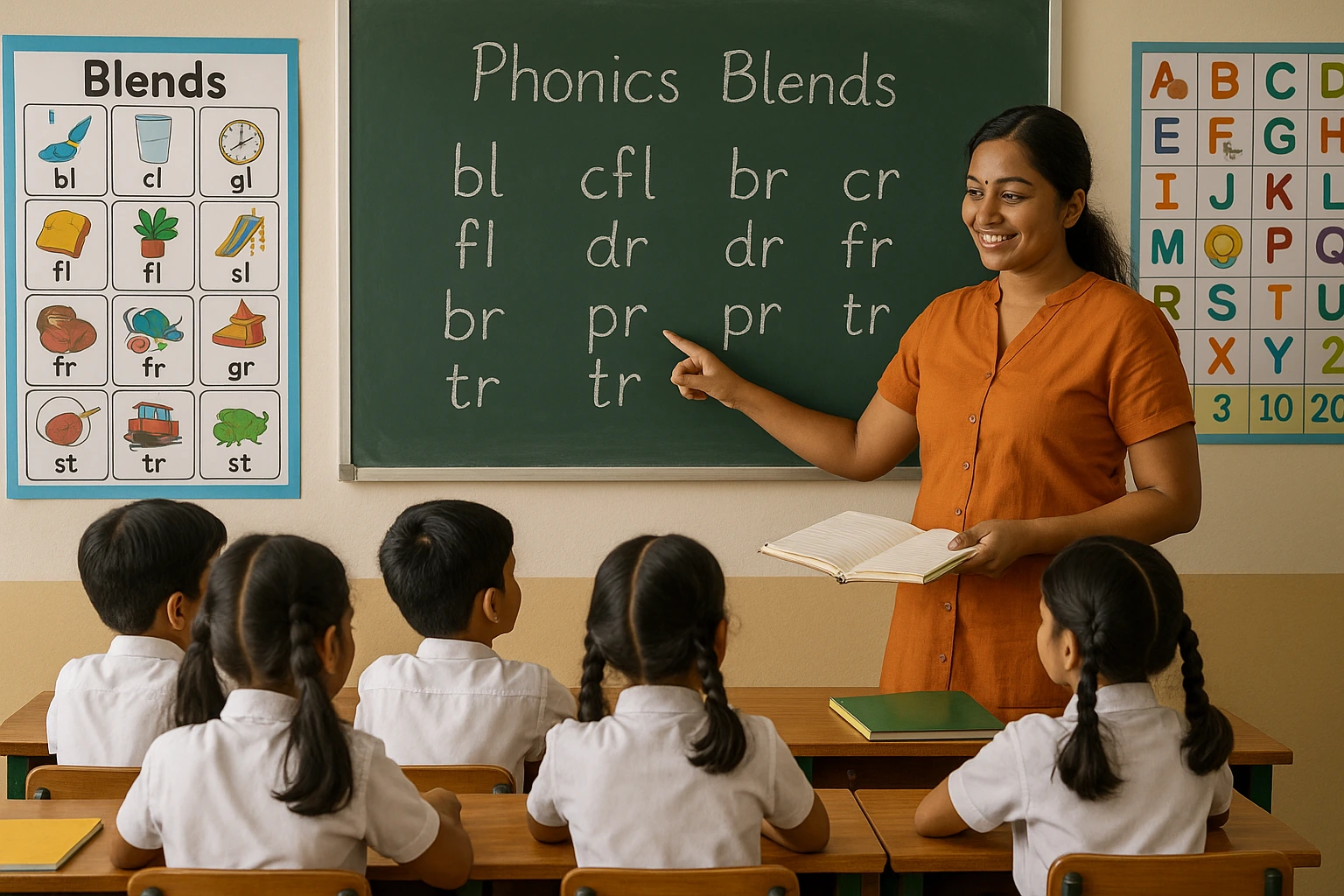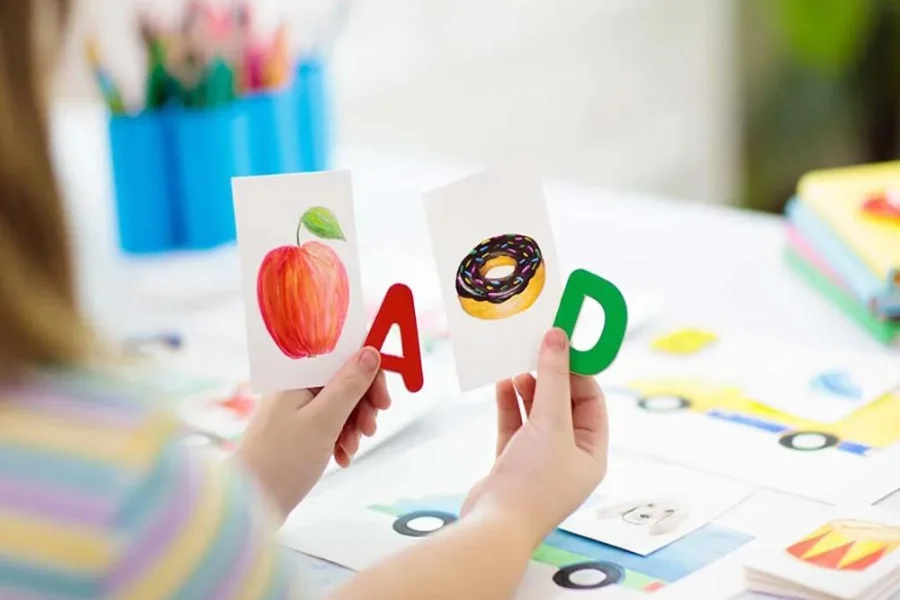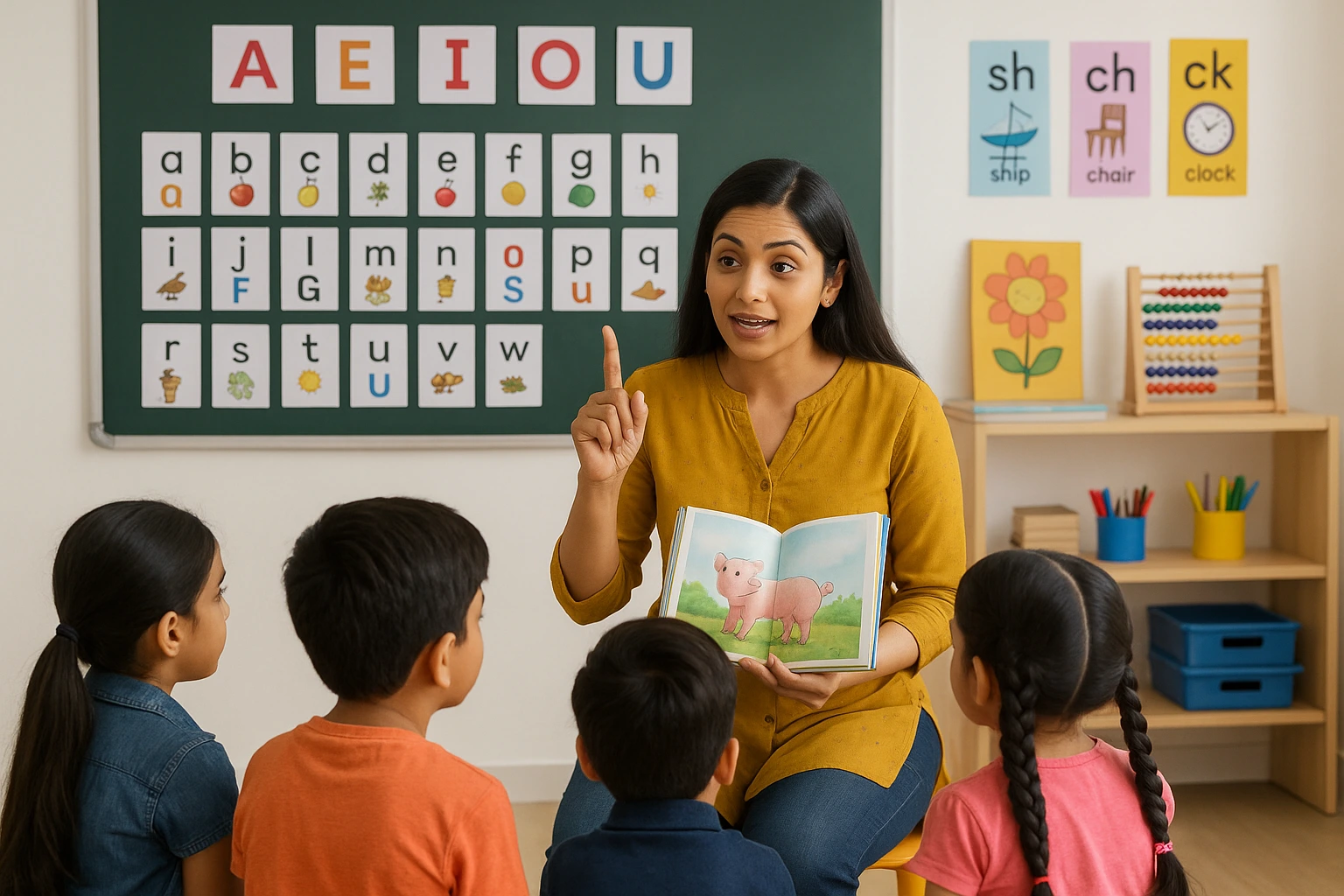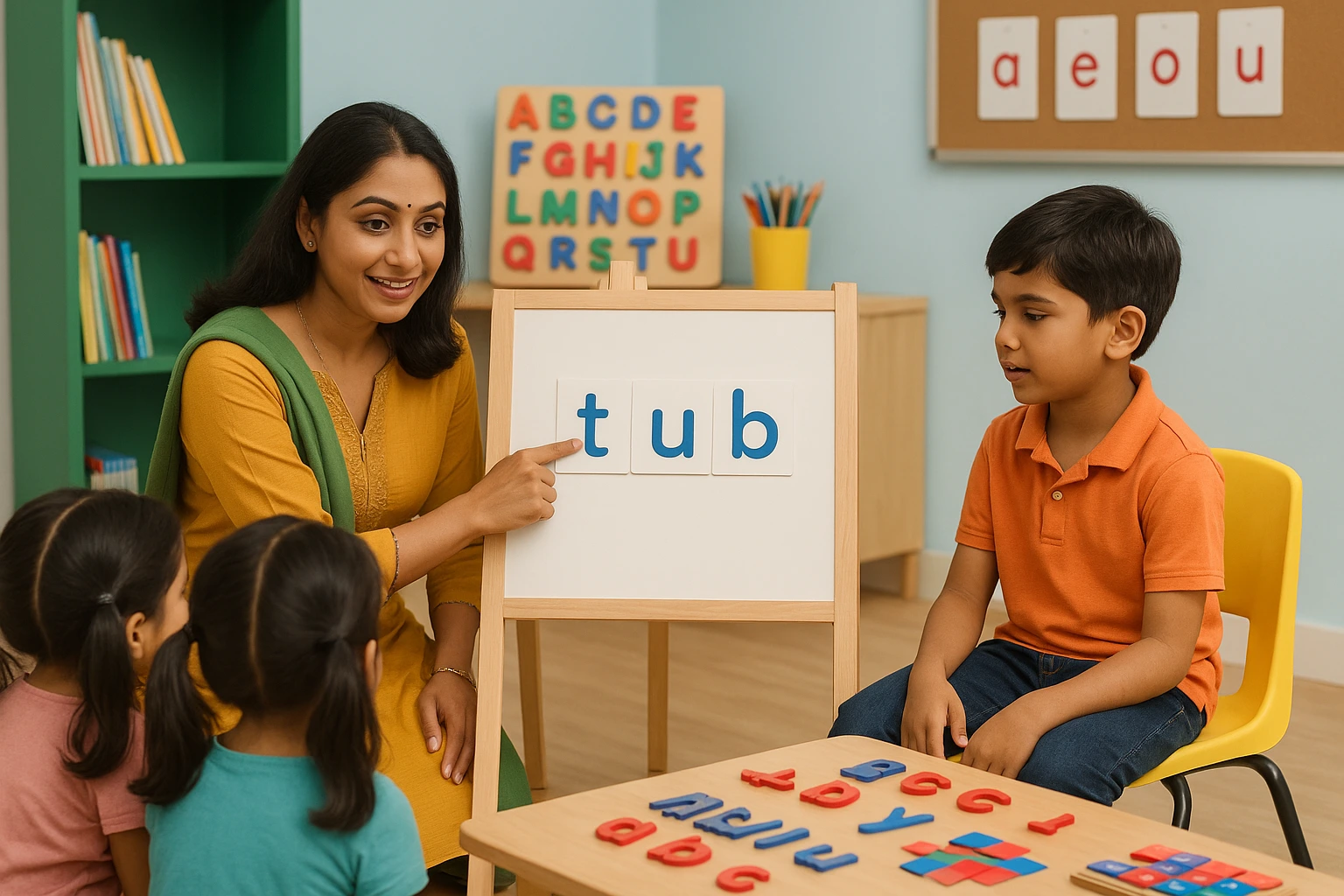How to Teach Letter Sounds Phonics A to Z?
How to Teach Letter Sounds Phonics A to Z?
Learning the sounds that letters produce helps children learn how to read. This approach, known as Letter Sounds Phonics, focuses on creating a robust foundation by associating each letter of the alphabet with its corresponding sound.
Understanding Letter Sounds Phonics is a fundamental step in early literacy, laying the foundation for prospective learning in young learners.
Table of Content
Should you Teach Letter Sounds or Letter Names First?
The query of whether to Teach Letter Sounds or Letter Names First always concerns teachers when teaching early literacy. Specialists suggest focusing on Letter Sounds before letter names. This approach supports reading readiness more effectively.
Teaching Letter Sounds first has several benefits:
- Direct link to reading: Children use letter sounds to decode words. Recognizing the sound /j/, /u/, /g/ in “jug” allows them to read it, whereas merely knowing the letter names does not directly aid reading.
- Builds phonemic understanding: Learning Letter Sounds helps children hear and control sounds, an essential skill for prospective learning.
- Supports spelling and writing: Once children learn the sounds, they can begin to spell words based on how they hear them.
On the other hand, letter names can be illogical initially. For instance, the letter “c” is called “see,” but its typical sound is /k/. This mismatch may cause uncertainties in decoding skills.
Once a concrete foundation in Phonics Letter Sounds is established, letter names can be presented gradually. Beginning with Phonics Letter Sounds gives children the means they need to associate articulated and written language, making early literacy instruction more effective and significant.
For downloading the brochure of Phonics Training Course, Click Here!
Call or Whatsapp on +918104606573 / +919869866277, for details of Phonics Training Course!

What is the Right Order to Teach Letter Sounds?
Determining the correct order of Letter Sounds training helps children master letters and sounds. Learning becomes much more effortless with a well-thought-out order. The Right Order to Teach Letter Sounds follows a routine that supports early literacy expansion while keeping learning dynamic.
Let us have a look at the Right Order to Phonics Letter Sounds for early literacy:
Start with Basic Consonants and Short Vowels
Begin with easy and commonly used letters such as p, i, s, n, a, t. These sounds can be smoothly blended to form primary words such as pan, sit, tip, etc. Introducing Letter Sounds via these letters qualifies children to begin blending early.
Move to Other Consonants
After children are convinced of the initial sounds, present other sounds such as m, d, g, o, c, and k. These help extend word-building abilities and strengthen the basis of Letter Sounds.
Introduce Digraphs Early
Sounds like sh, ch, th, and ng should be taught thereafter. These two-letter groups represent single sounds and are typical in everyday words, making them a vital part of the Letter Sounds program.
Add Long Vowel Sounds and Variants
Advance to long vowels and alternate spellings like ai, ee, ie, ay, etc, once primary phonics patterns are grasped. These help children comprehend vowel changes in Letter Sounds and read intricate words with confidence.
Teach Tricky Words Separately
Some words do not obey traditional Letter Sounds rules. Teach these high-frequency words individually to prevent chaos and support fluency.
A meticulous Order to Phonics Letter Sounds builds confidence and ensures children learn the core sounds essential for early reading success.
For downloading the brochure of Phonics Training Course, Click Here!
Call or Whatsapp on +918104606573 / +919869866277, for details of Phonics Training Course!

Source: toddlerjunction
How Many Letter Sounds should you Teach your Child at a Time?
A clarity of how many sounds to present at once is just as crucial as the technique used. Children grasp new details best when one element is introduced at a time. Overstuffing them with too many Phonics Letter Sounds at one time can lead to disarray and frustration.
Let’s determine How Many Letter Sounds should you Teach your Child at a Time:
Start with 1–2 Letter Sounds at a Time
When your child is just starting, begin by familiarizing only 1 to 2 Letter Sounds in one session. These can be the most generally used letter sounds like /t/, /s/, and /a/. Teaching fewer sounds allows children to concentrate, build acquaintance, and gain confidence.
Repeat and Reinforce
Before advancing further, ensure your child can identify and accurately replicate the previously taught ones. Use repetition through activities, flashcards, and storytelling to help the child master the sounds.
Observe a Weekly Cycle
A weekly rhythm works excellently for many children. Spend 5 to 6 days strengthening the current set of Letter Sounds Phonics before proceeding to the subsequent group. This pace supports long-term memory and sound blending ability.
Observe Readiness Signs
Different children have diverse learning capabilities. If your child spontaneously recognizes the sounds and blends them into basic words without elderly guidance, they’re ready to explore further Phonics Letter Sounds. If they err, slow down and spend additional time reviewing.
Patience and consistency make teaching Letter Sounds easy and help build a robust basis for reading. Teaching too many sounds at once can overwhelm, while the right pace promotes steady advancement.
For downloading the brochure of Phonics Training Course, Click Here!
Call or Whatsapp on +918104606573 / +919869866277, for details of Phonics Training Course!
How to Teach Letter Sounds to Children?
Teaching Phonics Letter Sounds builds a solid reading framework for young learners. When children learn how each letter sounds, they begin to comprehend word formation. This makes reading and spelling much more uncomplicated.
How to Teach Letter Sounds to Children:
Start with Simple Sounds
Initially, teach single consonant sounds. Letters like m, s, and t are easier to articulate and recall. Avoid teaching letters with identical sounds together to prevent chaos.
Use Visual and Auditory Cues
Visuals and sounds make learning more satisfactory. Letter graphs, flashcards, and phonics jingles help associate the letter with its sound. Consistently hearing the right Letter Sounds Phonics helps strengthen recognition.
Relate with Everyday Objects
Relate each letter sound with objects children notice every day. For instance, f for fan, b for bus. This makes Phonics Letter Sounds relatable and more straightforward to recall.
Teach Short Vowel Sounds Early
Short vowels form the ground of many simple words. Teaching a, e, i, o, and u creates a robust basis in Letter Sounds Phonics. Use photo books and jingles that support these vowel sounds.
Review and Repeat
Repetition promotes recollection. Review previously learned sounds periodically. Keep the sessions brief and entertaining to preserve interest.
Blend Sounds to Form Words
Then teach blending sounds. Begin with the bending of two-letter groups, such as an, it, on, at, etc., then advance to three-letter words.
Children develop confidence and mastery with Phonics Letter Sounds with a systematic instruction approach. This strategy makes early reading fun and more successful.
For downloading the brochure of Phonics Training Course, Click Here!
Call or Whatsapp on +918104606573 / +919869866277, for details of Phonics Training Course!

Fun Ways to Teach Letter Sounds
Teaching Phonics Letter Sounds can be fun when the right methods are adopted. Children learn sufficiently through play, repetition, and interaction. Making learning fun helps them connect better with the sounds of each letter. To gain expert knowledge in teaching phonics the right way, consider joining Vidhyanidhi Education Society’s (Govt. Regd.) Phonics Teacher Training Course, which trains educators in creative methods to Teach Phonics Letter Sounds effectively.
The following Fun Ways to Teach Letter Sounds Phonics can be adopted by teachers:
Sound and Picture Match
Use flashcards with pictures and letters. Let children match the beginning sound of the word to the correct letter. This strengthens their ability to associate sounds with letters.
Phonics Songs and Chants
Rhythmic songs with repetitive letter sounds help children memorize easily. For example, songs like “A says a, a, apple” work wonders for auditory learners.
Alphabet Sound Games
Using Letter Sounds Phonics, play games like “I Spy with my tiny eyes something that starts with /t/”, and let children discover the object.
Sand Tray Writing
Have kids write letters in sand while saying the sound aloud. This sensory method connects touch with Letter Sounds Phonics.
Story Time Sound Hunt
Read short stories and ask children to clap whenever they hear a specific letter sound. This improves listening skills and sound recognition.
Letter Sound Art
Create crafts or drawings for each letter. For example, make a collage of all things that begin with the letter “S” while repeating the /s/ sound.
To master these creative techniques, enroll in Vidhyanidhi Education Society’s (Govt. Regd.) Phonics Teacher Training Course. This Phonics Teacher Training Course not only trains you in techniques to Teach Letter Sounds Phonics but also adds credentials for future success. Selecting the Phonics Teacher Training Course ensures you’re prepared to make learning fun and significant for young minds.
Master phonics skills—join Vidhyanidhi’s Phonics Training Course today!
For downloading the brochure of Phonics Training Course, Click Here!
Call or Whatsapp on +918104606573 / +919869866277, for details of Phonics Training Course!
FAQs
Should I Teach Uppercase or Lowercase First?
As lowercase letters appear more often in reading and writing, beginning with them is suitable for early literacy.
Should Letter Names and Sounds be Taught Together?
Focus on letter sounds first for better reading readiness; introduce names gradually alongside familiar sounds for better recall





